KIA CEED 2015 Owners Manual
Manufacturer: KIA, Model Year: 2015, Model line: CEED, Model: KIA CEED 2015Pages: 1210, PDF Size: 35.92 MB
Page 1181 of 1210
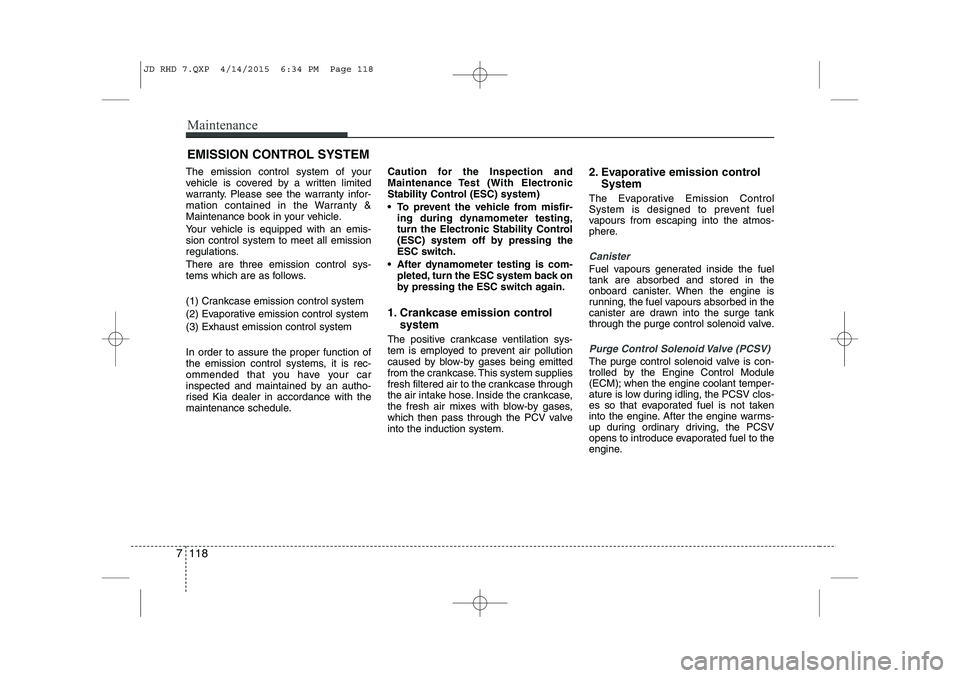
Maintenance
118
7
EMISSION CONTROL SYSTEM
The emission control system of your
vehicle is covered by a written limited
warranty. Please see the warranty infor-
mation contained in the Warranty &
Maintenance book in your vehicle.
Your vehicle is equipped with an emis- sion control system to meet all emission
regulations. There are three emission control sys-
tems which are as follows.
(1) Crankcase emission control system
(2) Evaporative emission control system(3) Exhaust emission control system In order to assure the proper function of
the emission control systems, it is rec-
ommended that you have your car
inspected and maintained by an autho-
rised Kia dealer in accordance with the
maintenance schedule. Caution for the Inspection and
Maintenance Test (With Electronic
Stability Control (ESC) system)
To prevent the vehicle from misfir-
ing during dynamometer testing,
turn the Electronic Stability Control
(ESC) system off by pressing the
ESC switch.
After dynamometer testing is com- pleted, turn the ESC system back on
by pressing the ESC switch again.
1. Crankcase emission control system
The positive crankcase ventilation sys-
tem is employed to prevent air pollution
caused by blow-by gases being emitted
from the crankcase. This system supplies
fresh filtered air to the crankcase through
the air intake hose. Inside the crankcase,
the fresh air mixes with blow-by gases,
which then pass through the PCV valveinto the induction system. 2. Evaporative emission control
System
The Evaporative Emission Control
System is designed to prevent fuel
vapours from escaping into the atmos-
phere.
Canister
Fuel vapours generated inside the fuel tank are absorbed and stored in the
onboard canister. When the engine is
running, the fuel vapours absorbed in the
canister are drawn into the surge tank
through the purge control solenoid valve.
Purge Control Solenoid Valve (PCSV)
The purge control solenoid valve is con-
trolled by the Engine Control Module
(ECM); when the engine coolant temper-
ature is low during idling, the PCSV clos-
es so that evaporated fuel is not taken
into the engine. After the engine warms-
up during ordinary driving, the PCSV
opens to introduce evaporated fuel to the
engine.
JD RHD 7.QXP 4/14/2015 6:34 PM Page 118
Page 1182 of 1210
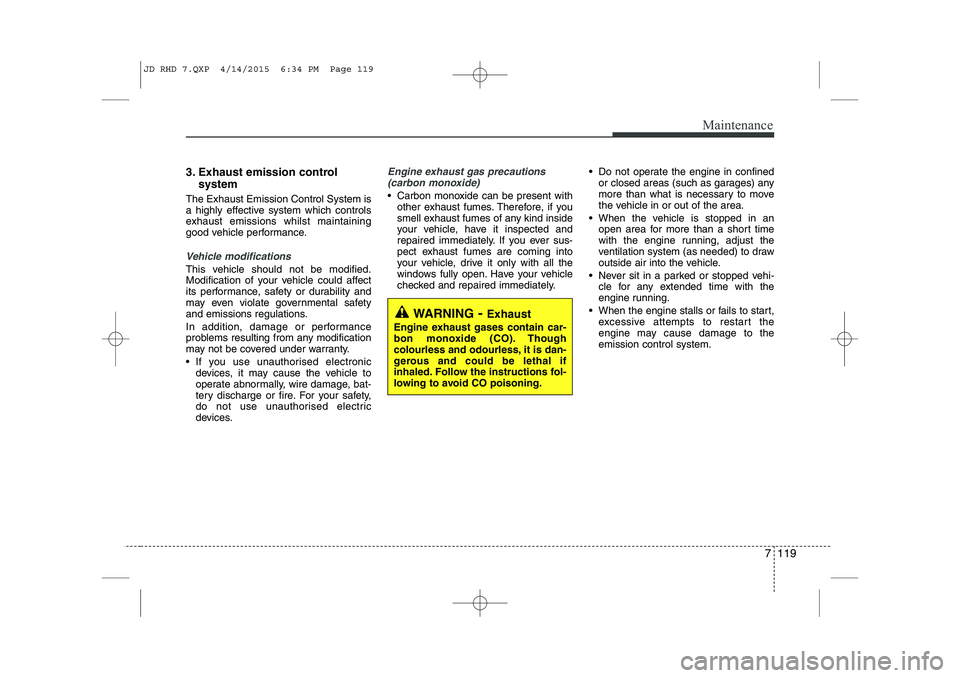
7 119
Maintenance
3. Exhaust emission control system
The Exhaust Emission Control System is
a highly effective system which controls
exhaust emissions whilst maintaining
good vehicle performance.
Vehicle modifications
This vehicle should not be modified.
Modification of your vehicle could affect
its performance, safety or durability and
may even violate governmental safety
and emissions regulations.
In addition, damage or performance
problems resulting from any modification
may not be covered under warranty.
If you use unauthorised electronic devices, it may cause the vehicle to
operate abnormally, wire damage, bat-
tery discharge or fire. For your safety,
do not use unauthorised electric
devices.
Engine exhaust gas precautions
(carbon monoxide)
Carbon monoxide can be present with other exhaust fumes. Therefore, if you
smell exhaust fumes of any kind inside
your vehicle, have it inspected and
repaired immediately. If you ever sus-
pect exhaust fumes are coming into
your vehicle, drive it only with all the
windows fully open. Have your vehicle
checked and repaired immediately. Do not operate the engine in confined
or closed areas (such as garages) any
more than what is necessary to move
the vehicle in or out of the area.
When the vehicle is stopped in an open area for more than a short time
with the engine running, adjust the
ventilation system (as needed) to draw
outside air into the vehicle.
Never sit in a parked or stopped vehi- cle for any extended time with the
engine running.
When the engine stalls or fails to start, excessive attempts to restart the
engine may cause damage to theemission control system.
WARNING - Exhaust
Engine exhaust gases contain car-
bon monoxide (CO). Though
colourless and odourless, it is dan-
gerous and could be lethal if
inhaled. Follow the instructions fol-
lowing to avoid CO poisoning.
JD RHD 7.QXP 4/14/2015 6:34 PM Page 119
Page 1183 of 1210
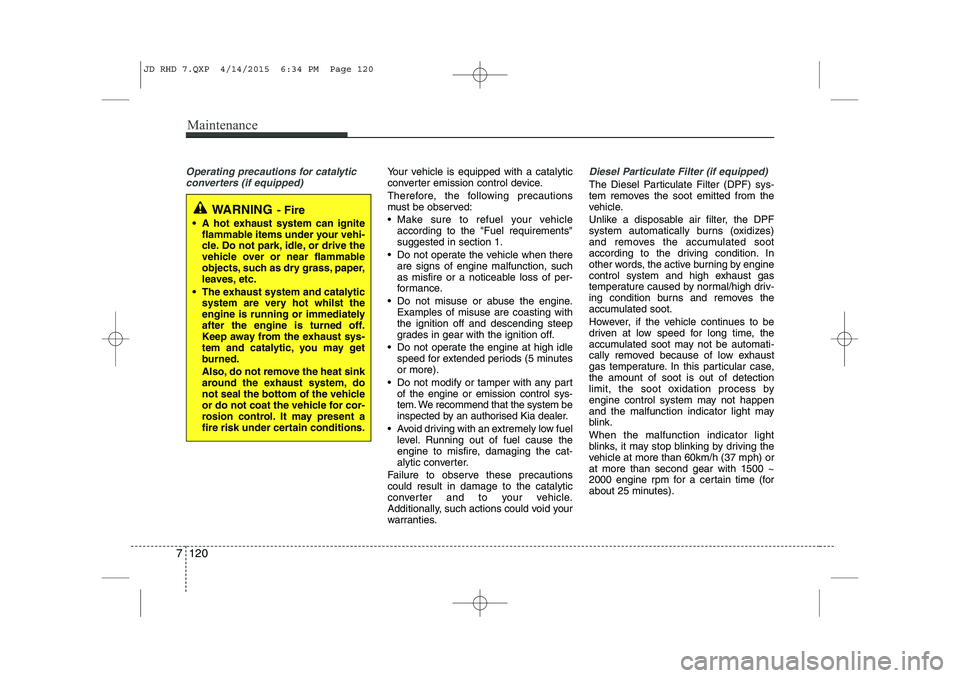
Maintenance
120
7
Operating precautions for catalytic
converters (if equipped)Your vehicle is equipped with a catalytic
converter emission control device.
Therefore, the following precautions
must be observed:
Make sure to refuel your vehicle according to the "Fuel requirements" suggested in section 1.
Do not operate the vehicle when there are signs of engine malfunction, such
as misfire or a noticeable loss of per-
formance.
Do not misuse or abuse the engine. Examples of misuse are coasting withthe ignition off and descending steep
grades in gear with the ignition off.
Do not operate the engine at high idle speed for extended periods (5 minutesor more).
Do not modify or tamper with any part of the engine or emission control sys-
tem. We recommend that the system be
inspected by an authorised Kia dealer.
Avoid driving with an extremely low fuel level. Running out of fuel cause the
engine to misfire, damaging the cat-
alytic converter.
Failure to observe these precautionscould result in damage to the catalytic
converter and to your vehicle.
Additionally, such actions could void your
warranties.Diesel Particulate Filter (if equipped)
The Diesel Particulate Filter (DPF) sys-
tem removes the soot emitted from the
vehicle.
Unlike a disposable air filter, the DPF
system automatically burns (oxidizes)
and removes the accumulated soot
according to the driving condition. In
other words, the active burning by engine
control system and high exhaust gas
temperature caused by normal/high driv-
ing condition burns and removes the
accumulated soot.
However, if the vehicle continues to be
driven at low speed for long time, the
accumulated soot may not be automati-
cally removed because of low exhaust
gas temperature. In this particular case,the amount of soot is out of detection
limit, the soot oxidation process by
engine control system may not happen
and the malfunction indicator light may
blink. When the malfunction indicator light
blinks, it may stop blinking by driving the
vehicle at more than 60km/h (37 mph) orat more than second gear with 1500 ~
2000 engine rpm for a certain time (for
about 25 minutes).
WARNING - Fire
A hot exhaust system can ignite flammable items under your vehi-
cle. Do not park, idle, or drive the
vehicle over or near flammable
objects, such as dry grass, paper,
leaves, etc.
The exhaust system and catalytic system are very hot whilst the
engine is running or immediately
after the engine is turned off.
Keep away from the exhaust sys-
tem and catalytic, you may get
burned.
Also, do not remove the heat sink
around the exhaust system, do
not seal the bottom of the vehicle
or do not coat the vehicle for cor-
rosion control. It may present a
fire risk under certain conditions.
JD RHD 7.QXP 4/14/2015 6:34 PM Page 120
Page 1184 of 1210
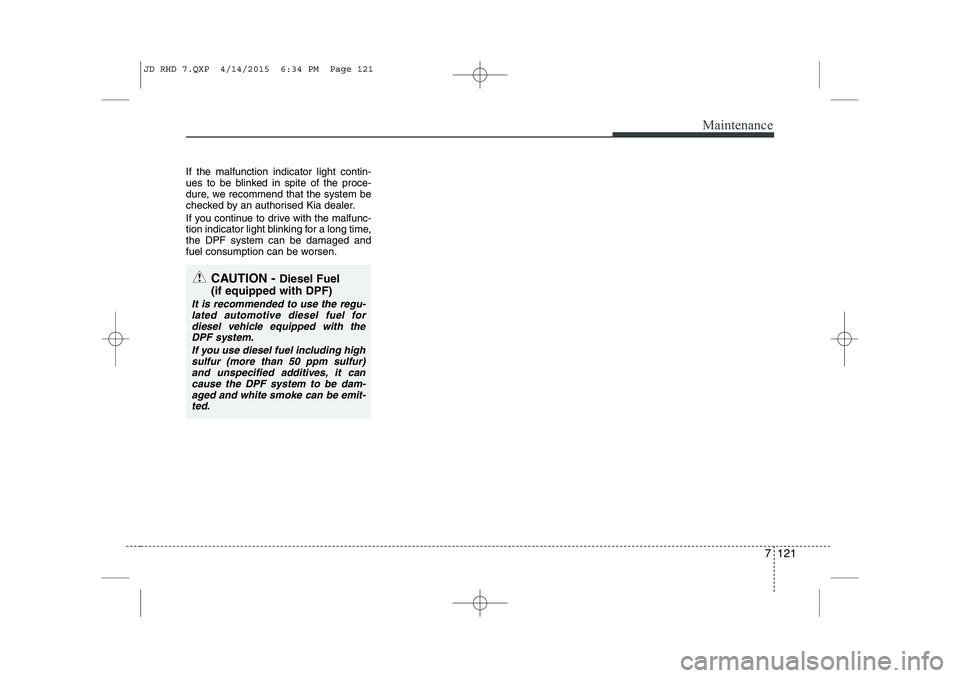
7 121
Maintenance
If the malfunction indicator light contin-
ues to be blinked in spite of the proce-
dure, we recommend that the system be
checked by an authorised Kia dealer.
If you continue to drive with the malfunc-
tion indicator light blinking for a long time,the DPF system can be damaged and
fuel consumption can be worsen.
CAUTION - Diesel Fuel
(if equipped with DPF)
It is recommended to use the regu- lated automotive diesel fuel fordiesel vehicle equipped with the
DPF system.
If you use diesel fuel including highsulfur (more than 50 ppm sulfur) and unspecified additives, it cancause the DPF system to be dam-
aged and white smoke can be emit-ted.
JD RHD 7.QXP 4/14/2015 6:34 PM Page 121
Page 1185 of 1210
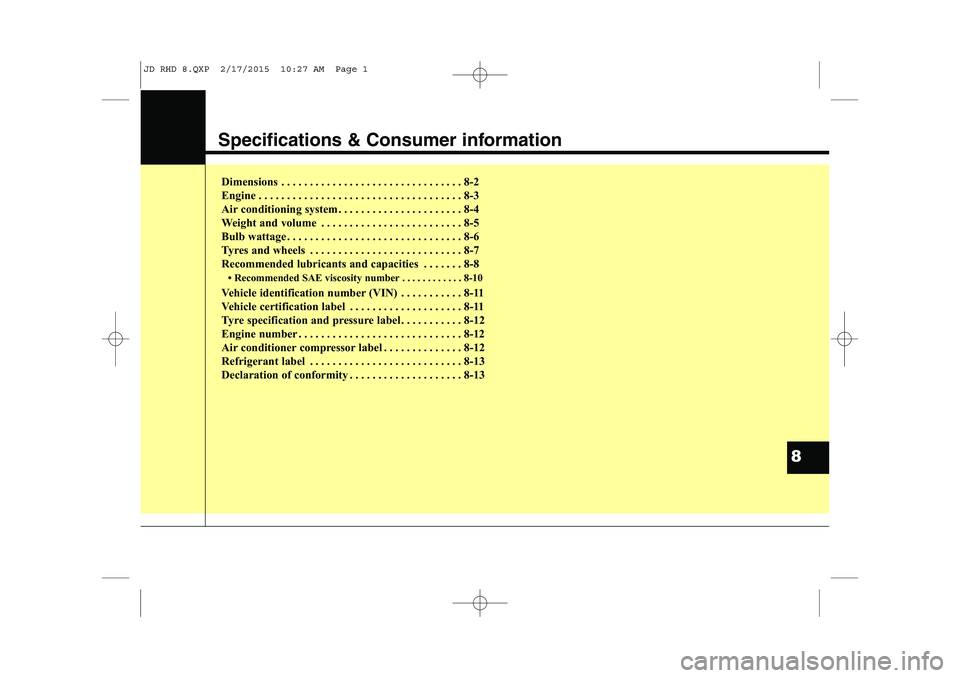
Specifications & Consumer information
Dimensions . . . . . . . . . . . . . . . . . . . . . . . . . . . . . . . . 8-2
Engine . . . . . . . . . . . . . . . . . . . . . . . . . . . . . . . . . . . . 8-3
Air conditioning system . . . . . . . . . . . . . . . . . . . . . . 8-4
Weight and volume . . . . . . . . . . . . . . . . . . . . . . . . . 8-5
Bulb wattage . . . . . . . . . . . . . . . . . . . . . . . . . . . . . . . 8-6
Tyres and wheels . . . . . . . . . . . . . . . . . . . . . . . . . . . 8-7
Recommended lubricants and capacities . . . . . . . 8-8 Recommended SAE viscosity number . . . . . . . . . . . . 8-10
Vehicle identification number (VIN) . . . . . . . . . . . 8-11
Vehicle certification label . . . . . . . . . . . . . . . . . . . . 8-11
Tyre specification and pressure label . . . . . . . . . . . 8-12
Engine number . . . . . . . . . . . . . . . . . . . . . . . . . . . . . 8-12
Air conditioner compressor label . . . . . . . . . . . . . . 8-12
Refrigerant label . . . . . . . . . . . . . . . . . . . . . . . . . . . 8-13
Declaration of conformity . . . . . . . . . . . . . . . . . . . . 8-13
8
JD RHD 8.QXP 2/17/2015 10:27 AM Page 1
Page 1186 of 1210
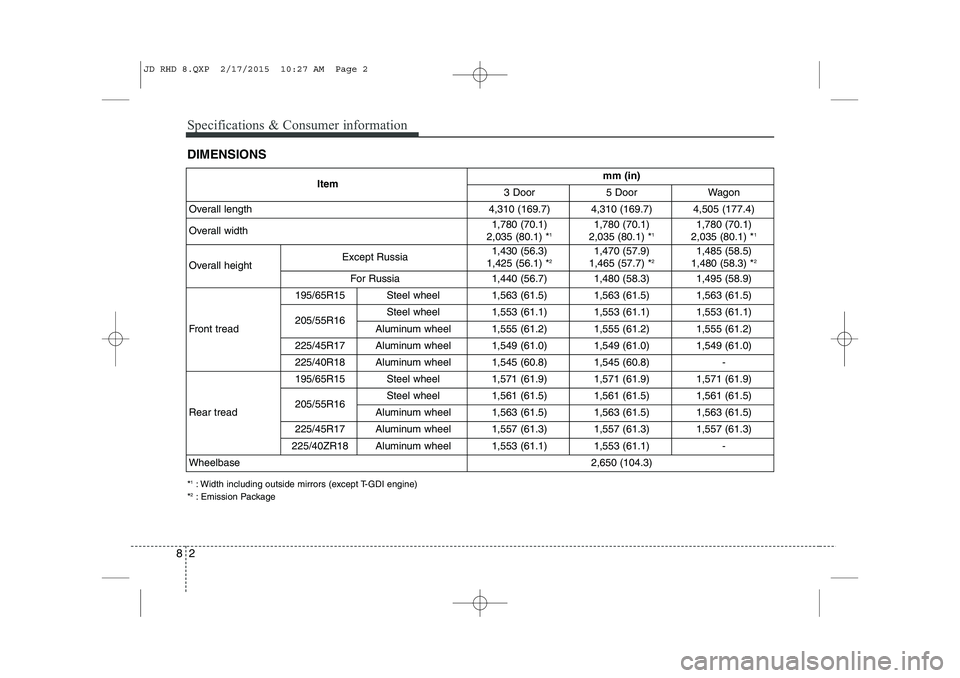
Specifications & Consumer information
2
8
DIMENSIONS
Itemmm (in)
3 Door 5 DoorWagon
Overall length4,310 (169.7)4,310 (169.7)4,505 (177.4)
Overall width1,780 (70.1)
2,035 (80.1) * 11,780 (70.1)
2,035 (80.1) * 11,780 (70.1)
2,035 (80.1) * 1
Overall height Except Russia1,430 (56.3)
1,425 (56.1) * 21,470 (57.9)
1,465 (57.7) * 21,485 (58.5)
1,480 (58.3) * 2
For Russia1,440 (56.7)1,480 (58.3)1,495 (58.9)
Front tread
195/65R15Steel wheel1,563 (61.5)1,563 (61.5)1,563 (61.5)
205/55R16Steel wheel1,553 (61.1)1,553 (61.1)1,553 (61.1)
Aluminum wheel1,555 (61.2)1,555 (61.2)1,555 (61.2)
225/45R17Aluminum wheel1,549 (61.0)1,549 (61.0)1,549 (61.0)
225/40R18Aluminum wheel1,545 (60.8)1,545 (60.8)-
Rear tread
195/65R15Steel wheel1,571 (61.9)1,571 (61.9)1,571 (61.9)
205/55R16Steel wheel1,561 (61.5)1,561 (61.5)1,561 (61.5)
Aluminum wheel1,563 (61.5)1,563 (61.5)1,563 (61.5)
225/45R17Aluminum wheel1,557 (61.3)1,557 (61.3)1,557 (61.3)
225/40ZR18Aluminum wheel1,553 (61.1)1,553 (61.1)-
Wheelbase2,650 (104.3)
*
1
: Width including outside mirrors (except T-GDI engine)
* 2
: Emission Package
JD RHD 8.QXP 2/17/2015 10:27 AM Page 2
Page 1187 of 1210
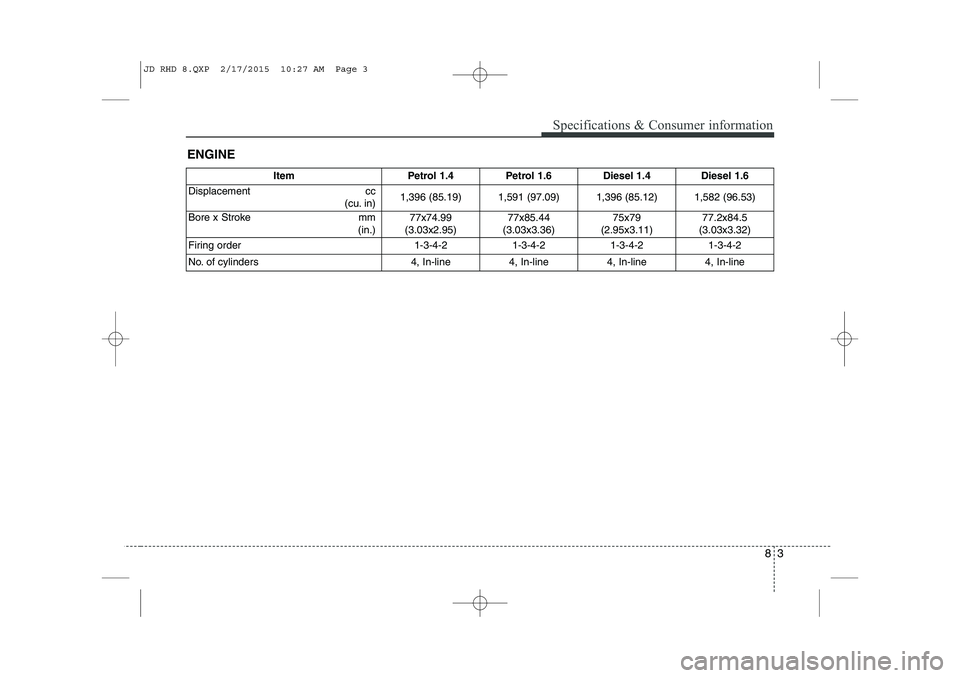
83
Specifications & Consumer information
ENGINEItem Petrol 1.4 Petrol 1.6 Diesel 1.4
Diesel 1.6
Displacement cc (cu. in) 1,396 (85.19) 1,591 (97.09) 1,396 (85.12)
1,582 (96.53)
Bore x Stroke mm (in.)77x74.99
(3.03x2.95) 77x85.44
(3.03x3.36) 75x79
(2.95x3.11)
77.2x84.5
(3.03x3.32)
Firing order 1-3-4-2 1-3-4-2 1-3-4-2
1-3-4-2
No. of cylinders 4, In-line 4, In-line 4, In-line
4, In-line
JD RHD 8.QXP 2/17/2015 10:27 AM Page 3
Page 1188 of 1210
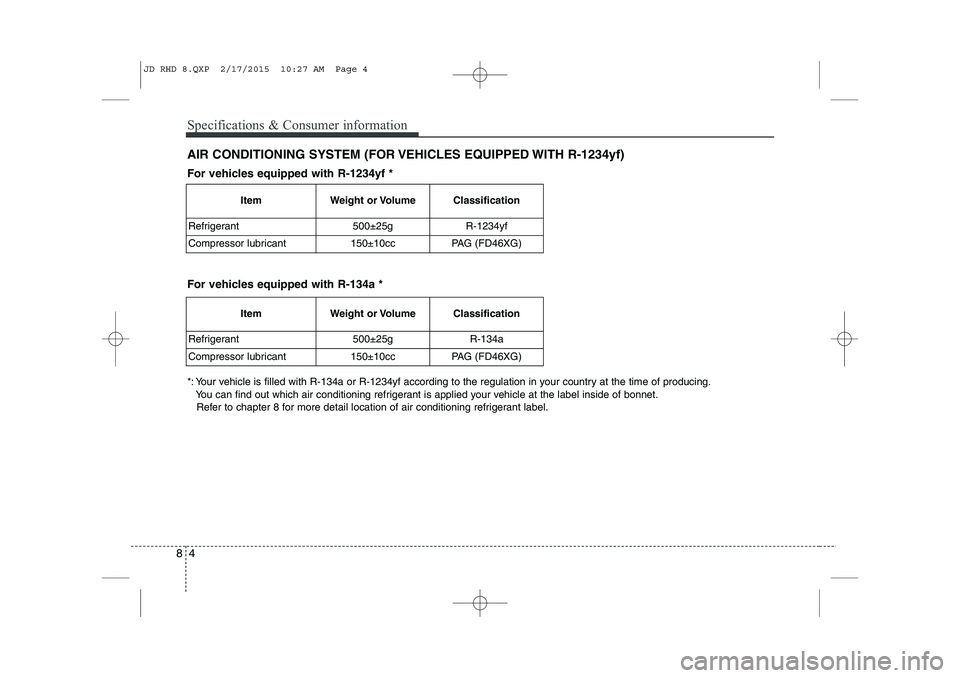
Specifications & Consumer information
4
8
AIR CONDITIONING SYSTEM (FOR VEHICLES EQUIPPED WITH R-1234yf)
Item Weight or Volume Classification
Refrigerant 500±25g R-1234yf
Compressor lubricant 150±10cc PAG (FD46XG)
For vehicles equipped with R-1234yf *
For vehicles equipped with R-134a *
Item Weight or Volume Classification
Refrigerant 500±25g R-134a
Compressor lubricant 150±10cc PAG (FD46XG)
*: Your vehicle is filled with R-134a or R-1234yf according to the regulation in your country at the time of producing. You can find out which air conditioning refrigerant is applied your vehicle at the label inside of bonnet.Refer to chapter 8 for more detail location of air conditioning refrigerant label.
JD RHD 8.QXP 2/17/2015 10:27 AM Page 4
Page 1189 of 1210
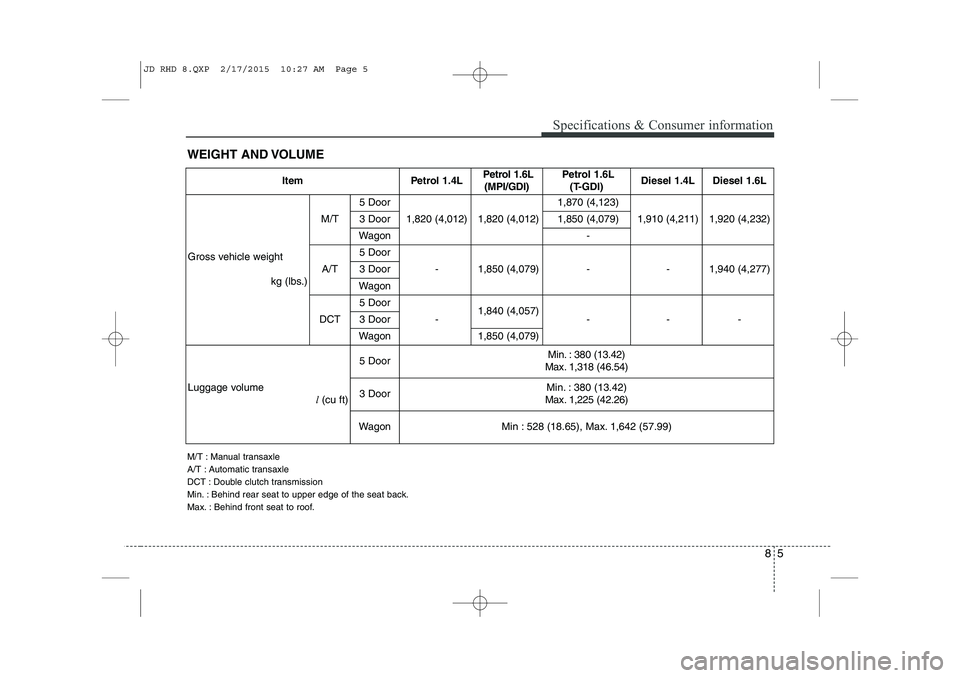
85
Specifications & Consumer information
WEIGHT AND VOLUME
M/T : Manual transaxle
A/T : Automatic transaxle
DCT : Double clutch transmission
Min. : Behind rear seat to upper edge of the seat back.
Max. : Behind front seat to roof.Item Petrol 1.4L
Petrol 1.6L
(MPI/GDI) Petrol 1.6L
(T-GDI) Diesel 1.4L Diesel 1.6L
Gross vehicle weight kg (lbs.)M/T
5 Door
1,820 (4,012) 1,820 (4,012) 1,870 (4,123)
1,910 (4,211) 1,920 (4,232)
3 Door1,850 (4,079)
Wagon -
A/T 5 Door
- 1,850 (4,079) - - 1,940 (4,277)
3 Door
Wagon
DCT 5 Door
- 1,840 (4,057)
- - -
3 Door
Wagon 1,850 (4,079)
Luggage volume l(cu ft) 5 Door
Min. : 380 (13.42)
Max. 1,318 (46.54)
3 Door Min. : 380 (13.42)
Max. 1,225 (42.26)
Wagon Min : 528 (18.65), Max. 1,642 (57.99)
JD RHD 8.QXP 2/17/2015 10:27 AM Page 5
Page 1190 of 1210
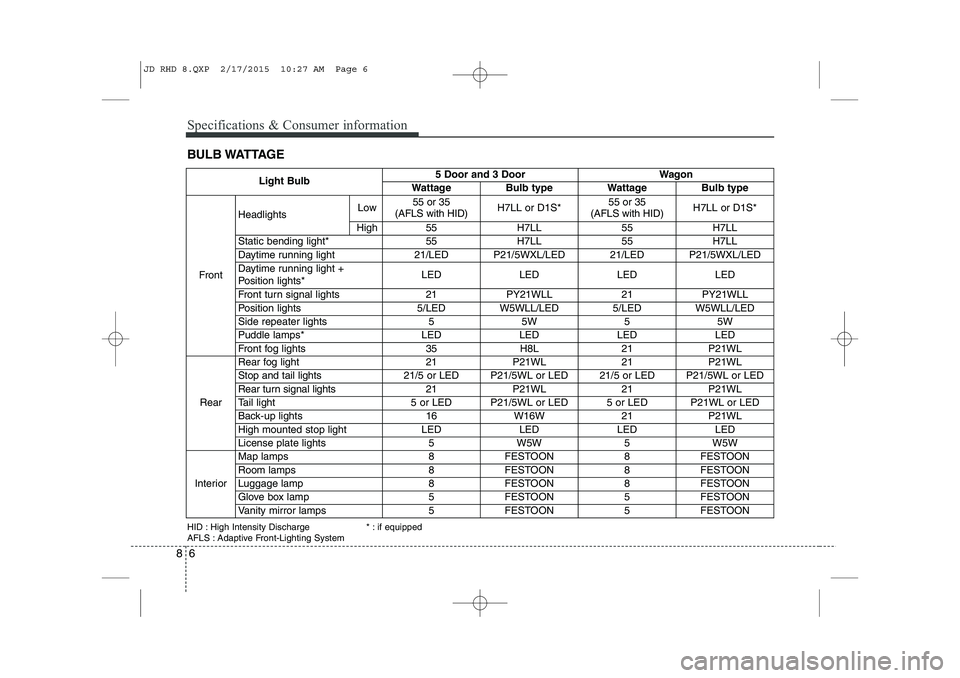
Specifications & Consumer information
6
8
BULB WATTAGE
Light Bulb5 Door and 3 DoorWagon
WattageBulb typeWattageBulb type
Front
HeadlightsLow55 or 35
(AFLS with HID)H7LL or D1S*55 or 35
(AFLS with HID)H7LL or D1S*
High55H7LL55H7LL
Static bending light*55H7LL55H7LL
Daytime running light21/LEDP21/5WXL/LED21/LEDP21/5WXL/LED
Daytime running light +
Position lights*LEDLEDLEDLED
Front turn signal lights21PY21WLL21PY21WLL
Position lights5/LEDW5WLL/LED5/LEDW5WLL/LED
Side repeater lights55W55W
Puddle lamps*LEDLEDLEDLED
Front fog lights35H8L21P21WL
Rear
Rear fog light21P21WL21P21WL
Stop and tail lights 21/5 or LEDP21/5WL or LED21/5 or LEDP21/5WL or LED
Rear turn signal lights 21P21WL21P21WL
Tail light 5 or LEDP21/5WL or LED5 or LEDP21WL or LED
Back-up lights 16W16W21P21WL
High mounted stop lightLEDLEDLEDLED
License plate lights5W5W5W5W
Interior
Map lamps8FESTOON8FESTOON
Room lamps8FESTOON8FESTOON
Luggage lamp8FESTOON8FESTOON
Glove box lamp5FESTOON5FESTOON
Vanity mirror lamps5FESTOON5FESTOON
HID : High Intensity Discharge
AFLS : Adaptive Front-Lighting System * : if equipped
JD RHD 8.QXP 2/17/2015 10:27 AM Page 6